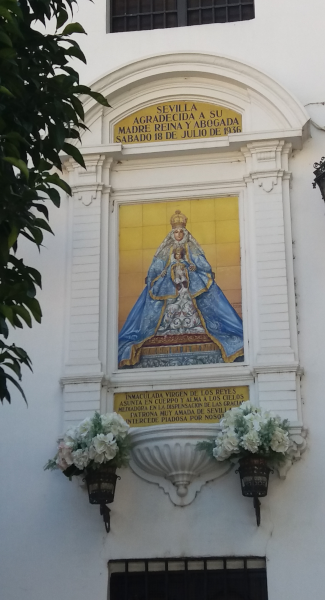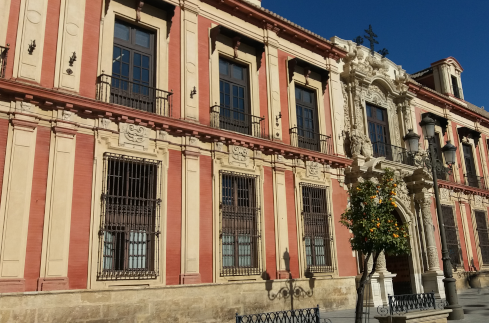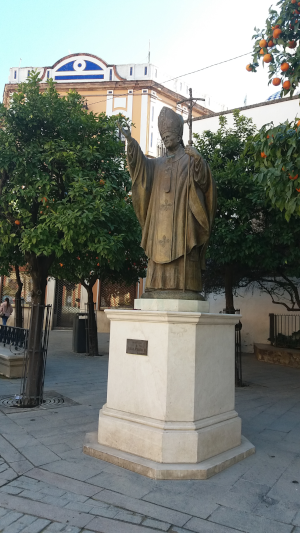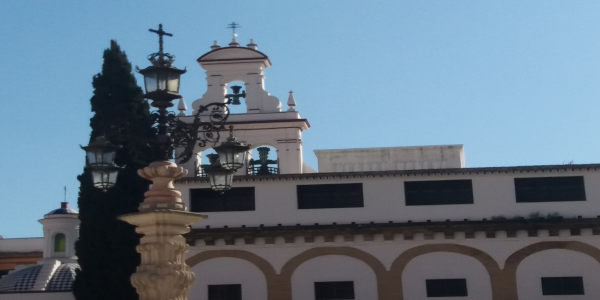The Square of the Virgen de los Reyes (Our Lady of the Kings) in Seville is one of the most unique spaces in the city.

The Virgen de los Reyes (Our Lady of the Kings)
This image of the Virgen de los Reyes is the General or Principal Patroness of Seville (proclaimed as such by Pius XII in 1946) and of the Archdiocese.
She is venerated inside the Cathedral, in the Royal Chapel.
It was the first Virgin of Andalusia to be canonically crowned in 1904.
Every year on August 15 (the day of the Assumption), the Virgen de los Reyes is taken out in procession. Many Sevillians make a break in their vacations to see their patroness in her processional route around the city
The image, carved in the thirteenth century, is Gothic in style and therefore very schematic in its features. It is made of larch wood and has a height of 1.76 meters. On her lap she holds an image of the Child (also from the 13th century but somewhat later).
The origin of the image
It was probably made in France (the most widespread theory since the Virgin wears original 13th century shoes decorated with fleurs-de-lis) or perhaps in Germany. In both countries a type of images was popularized that had articulated limbs (only the head, hands and feet are sculpted) and it was possible to turn the head thanks to a mechanism of cogwheels and straps, so that only the head, hand and feet are modeled. These figures were called “marionettes” or “little Marys” and were used in certain religious representations. Our Lady of the Kings responds to these characteristics. It would have been donated to Ferdinand III and it is more than likely that it participated in the events held at the capture of the city.
We know from the Cantigas of Alfonso X that Fernando III had a great devotion to the Virgin Mary. The legend says that, having put siege to Seville, Fernando III manifested his desire to possess an image of the Virgin. For it he summoned famous sculptors, without being satisfied with any of the works made. One day three young men appeared in the camp offering to carry out the commission. They were allowed to retire to a nearby tower where, undisturbed, they would carry out their work. The king, after some time, restless and expectant, sent to inquire about the work, and those who went to the tower found a beautiful image; the current Virgin of the Kings, but the young men had disappeared without anyone knowing how to give news of them, coming to the conclusion that they were actually angels sent by Heaven.
The Corral de los Olmos
Occupying a large part of the current Plaza de la Virgen de los Reyes, since the Reconquest of the city was the so-called Corral de los Olmos. It was made up of a group of buildings more or less attached to a stretch of the Muslim wall that connected the Alcazar and the Aljama Mosque.
Among these buildings stood out in height and dignity a square tower of Mudejar style that was used as the center of the Ecclesiastical and Secular Councils of the city.
In the 16th century, several circumstances caused the Corral de los Olmos to begin to be questioned as the seat of the two councils. Although its location was privileged, the offenders who frequented the nearby inns degraded the area.
Since the Chamber of Comerce was established in Seville in 1503, the city became a very important commercial center that could hardly be represented in a building of such modest construction. In addition, the increased bureaucracy of the Modern State implied a significant increase in the number of members of the Cabildo and service personnel, which meant that the building was becoming insufficient in size.
All the drawbacks of the Corral de los Olmos became evident after the marriage of Charles V and Isabella of Portugal in the city in 1526. On that occasion, the Council and the Cabildo received the large imperial entourageby the Cathedral and not in their headquarters, as would have been mandatory, such were the shortcomings of the building.
Shortly after the royal wedding, the Council (Cabildo Secular) decided to erect a new building that would serve as a dignified and representative headquarters: the current extraordinary City Hall (begun in 1527, it was not occupied by the Council until well into the second part of the century).
The Ecclesiastical Chapter continued for a longer period in the old building, until its magnificent rooms inside the cathedral were completed at the end of the 16th century.
The old building was demolished at the end of the 18th century.
The fountain
In the center of the Plaza de la Virgen de los Reyes there is a beautiful five-armed candelabra fountain with wrought iron lanterns by José Lafita Díaz. It could be considered of regionalist style. It was inaugurated in 1930.

The Archbishop´s Palace
One of the sides of the square is occupied by the Archbishop’s Palace, which was built on the site donated in 1251 by Fernando III to Bishop Don Remondo so that he could build the so-called Archbishop’s Houses, of which there are no remains today.
The oldest remains of the present palace date back to the 16th century. Throughout this century and the 17th century, the building underwent an extensive process of improvements and extensions that culminated in the transformation of the old Archbishop’s Houses into a real palace.
Important were the works carried out at the beginning of the 17th century by Vermondo Resta.
Extraordinary is the main hall (1604), which has the most richly painted ceiling of all Sevillian palaces and an outstanding collection of more than 70 paintings (Murillo, Zurbrán, Espinal).
Between 1703 and 1705, Lorenzo Fernández de Iglesias carved the main doorway, simply one of the most attractive achievements of Baroque Seville.
Since 2009, Juan José Asenjo, who replaced Carlos Amigo Vallejo, has been Archbishop of Seville.
Part of the oldest areas of the Palace, especially those corresponding to the gardens, are now part of the hotel Los Seises.
In 1756 the arches that connected the Giralda with the Archbishop’s Palace were demolished.
The Convent of the Incarnation
Opposite the Archbishop’s Palace is the Convent of the Incarnation. Just in front of this convent is the Monument to John Paul II, a bronze sculpture made by the professor of Fine Arts of Seville Juan Manuel Miñarro.

The Pope was in Seville on two occasions: In 1982, on the occasion of the beatification of Sister Angela de la Cruz, and in 1993, to close the XLV International Eucharistic Congress.

Both the church of the Convent of the Incarnation and its main body were part of the Hospital of Santa Marta, which had been founded in 1385 by the archdeacon of Ecija, Ferrán Martínez.
Possibly, part of the present building could have been a mosque in Islamic times (there are remains in its structure that could prove it.. Interesting is also the tower that could have been part of the Almohad defensive system.
The transfer to this building of the Augustinian nuns of the Convent of the Incarnation was caused by the demolition of their primitive convent, in 1811, during the French occupation.
It is known that to help with the maintenance expenses, the convent manufactures Sacred Forms that are acquired by the churches of Seville.
Of course the Giralda and the Cathedral are also located in this Plaza de la Virgen de Los Reyes.
From Showmesevilla we would be delighted to accompany you to discover this beautiful square. Do not hesitate to contact us for a customized visit.








No comments yet.